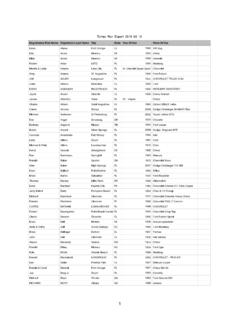Transcription of ESPONSE TO HASE 2 EQUEST FOR ROPOSALS FOR THE …
1 70 TPH MRF, Brooklyn, NY RESPONSE TO PHASE 2 REQUEST FOR PROPOSALS FOR THE FINANCING, DESIGN, CONSTRUCTION, OPERATION AND MAINTENANCE OF A SOLID WASTE MANAGEMENT PROJECT mustang RENEWABLE POWER VENTURES, LLC 17 CORPORATE PLAZA, SUITE 200 NEWPORT BEACH, CA 92660 PHONE (805) 259-9499 CSWS RRF Proposed Site Plan Fairhaven Power Block Facility, Connecticut Redeveloped 290,000 TPY MRF + AD Santa Barbara County, CA RFP RESPONSE SECTION 2. EXECUTIVE SUMMARY PROBLEM/OPPORTUNITY IN 88 WORDS The CSWS RRF has arguably reached the end of its functional life. Decreasing power prices combined with increasing 1980 s WTE plant CapEx/O&M costs could materially increase tip fees inspiring ratepayer heartburn and wholesale town opt out. Waste processing technologies have advanced exponentially over the past 30 years with reduced CapEx/O&M, full automation, increased recyclable recovery, renewable energy capture while greatly reducing greenhouse gases.
2 The mustang Project delivers 70% diversion at competitive tip fees using low risk/proven, 21st century, environmentally superior technologies: Mixed Waste Processing + Anaerobic Digestion/Composting + Engineered Fuel. 2 RFP RESPONSE Project Fundamentals Reuse Existing Waste Processing Facility (Reduced CapEx and Tip Fees) Repurpose as Mixed Waste Processing Facility Operated by Sims Municipal Recycling Construct AD Facility for Organics Processing and Class 1 Renewable Energy Construct Composting Boxes on site (Herhof) Off site composting, storage and marketing by Harvest Power Process Engineered Fuel from residue to industrial facilities Rail Export Residue to Remote Landfill (Casella PA &/or Tunnel Hill) ~660,000/year mTCO2e GHG reduction benefits from recycling, AD/Composting and PEF vs.
3 Existing WtE plant Discontinue WtE Plant Operations Making facility and site available for alternative uses 3 RFP RESPONSE PROJECT COMPONENTS 4 RFP RESPONSE MASS BALANCE PHASE 1 5 RFP RESPONSE MASS BALANCE PHASE 2 6 RFP RESPONSE 7 RFP RESPONSE 8 RFP RESPONSE PROJECT DESCRIPTION AND PROPOSED TECHNOLOGIES The mustang Team approach is to push the frontier of diversion and recovery, to test and develop markets and technologies, and to actively employ the best technologies, individuals and companies in the industry. At the same time, with many decades of experience as facility developers, equipment designers and waste service providers, plant operators, and material marketers, the proposed Project is careful to build from commercially proven and successful operating reference facilities, taking full account of commodity market fluctuations, technology s potential and limitations, the ever-changing nature of the waste stream, and compliance with evolving regulations and public expectations.
4 mustang proposes a facility that is robust and flexible, ensuring adequate capacity and appropriate redundancies to reliably handle the required volumes, and the ability to adjust to changing waste composition, regulations and markets over the life of the contract. In addition, the mustang Team is sensitive to program costs, municipal budgets, and the need to optimize recovery and diversion within a cost-effective framework. There is no doubt that over the projected 30-year life of the Project, new technologies and markets and changes in the waste stream will create new opportunities for cost-effective materials recovery/diversion, and the mustang Team will be prepared to take advantage of these opportunities as they arise. The Team assumes at the outset, the initial Project design should allow the MIRA municipalities to achieve a minimum 60% diversion rate in the most cost-effective manner possible, with additional diversion targeted only where it can be accomplished without adding to overall per ton system costs.
5 According to the RFP, the current diversion rate, achieved through source-separated recycling, yard waste composting and other programs, is 35%. To reach a 60% diversion threshold, 38% of the remaining 65% must be diverted. The proposed Project is estimated to achieve a project diversion rate of ~70% implying a community diversion rate of ~71% ( , 35% + (~70% of 65% =) ~46% = ~71%). To meet and exceed the minimum diversion threshold for MIRA and its participating towns, mustang proposes a new integrated Resource Rediscovery Project comprised of the following components: 1) Transfer Stations. The existing three Transfer Stations (or four in the event the Ellington transfer station comes back on line), with select modifications and improvements.
6 mustang proposes to continue to operate the Transfer Stations for MSW and source-separated recyclables. Select non-processible waste will be segregated at the transfer stations. Some of these items, such as propane tanks and mattresses can be recycled. However, the tonnage of these materials is not expected to be significant. Therefore, while it will be tracked and reported, for purposes of achieving the target diversion rate, mustang assumes a <1% tonnage figure for these items. In addition to the contracted tonnages these transfer stations manage, mustang will seek to attract additional tonnage of both recyclables and MSW. To that end, the Team has had preliminary conversations with some of the major private haulers in the areas served by these Transfer Stations, as well as transfer station operators themselves.
7 However, for purposes of the mass balance, mustang does not, at this time, assume any additional tonnage from other sources. While not tied to diversion, mustang sees the potential to reduce the costs associated with recyclables that flow through the transfer stations. Currently transfer stations can achieve transfer trailer weights for recyclables that are 9 RFP RESPONSE approximately half that of MSW. This is in part due to the inherently less dense nature of recyclables compared to MSW. However, it is also due to the limited ability to compact materials at the transfer stations. With all MIRA facilities, including the transfer stations, rolled into one contract, mustang will be incentivized to optimize transfer stations costs, and with a 30-year contract, mustang will be able to justify strategic capital investment at transfer stations.
8 mustang does not expect to achieve the same load rates as MSW, however, the Team believes a 50% to 60% improvement in load weights is achievable. Not only will this reduce transport costs, but it will also reduce the number of trucks on the road and trucks entering the Hartford Murphy Road site. 2) SSR Processing. The existing MIRA Recycling Facility, with select modifications and upgrades, will continue processing the ~70,000 TPY of Source Separated Recyclables currently accepted and be capable of processing ~100,000 tpy. mustang /SMR will work with MIRA and the participating towns to grow this tonnage through education, outreach and participation improvements and by competing aggressively for available commercial/spot market SSR. SMR personnel have made several tours through the SSR MRF to inspect the process and equipment condition, and the budget includes capital dollars deemed necessary to bring the plant up to SMR safety standards and to ensure ongoing efficient operations and high recovery rates.
9 3) Mixed Waste Processing. A new, advanced mixed waste processing plant (or Mixed Waste MRF) to be located at the site and in the buildings of the existing CSWS. The Mixed Waste MRF will sort MSW to recover recyclables and segregate the organic fraction. The Mixed Waste MRF will be constructed in two phases: The first will process a minimum of ~465,000 TPY of MSW ( Phase 1). The second will process up to ~700,000 TPY of MSW, and recover an estimated 14% as marketable commodities ( , glass, metal, paper, plastic). The Mixed Waste MRF will further segregate an estimated 43% of the MSW as an organic fraction ( , food scraps, yard waste and unrecyclable paper), which is directed to a new on-site Anaerobic Digestion (AD) Facility & aerobic composting boxes. 10 RFP RESPONSE Van Dyk Recycling Solutions (VDRS) Multi-line Mixed Waste Processing Design For detailed research articles and white papers describing the diversion benefits/risks of Mixed Waste Processing please see the following: MSW Management, Nov-Dec 2015, Mixed Waste Processing Article: #{"page":38,"issue_id":274950} MSW Management, Nov-Dec 2015, Advanced Materials Processing Article: #{"page":44,"issue_id":274950} The Evolution of Mixed Waste Processing Facilities, 1970-Today, Gershman, Brickner & Bratton Mixed Waste Processing Economic and Policy Study, Burns McDonnell 11 RFP RESPONSE 4) Anaerobic Digestion.
10 A high-solids, dry fermentation AD Facility will be constructed on-site in two phases: Phase 1 will process up to ~100,000 tpy of the organic fraction of MSW (OFMSW) into compost and biogas, Phase 2 will process up to ~150,000 TPY of OFMSW similarly. The remaining tons of OFMSW in each phase are sent directly to aerated composting boxes. This split processing of the OFMSW is known as partial stream digestion. The AD Facility will use an anaerobic fermentation process in vertical digesters or silos. Steam is added as a supplemental heat to achieve a thermophilic AD cycle (>131 F) achieving pathogen reduction while producing methane-rich biogas. The biogas is cleaned up to natural gas grid standards and injected into the grid with a small portion sent to an on-site RNG Fuel Station. OWS Dry Anaerobic Composting (DRANCO) installation in Hille Germany Mixed Waste Processing FacilityOWS DRANCO AD Digester Aerated Enclosed Composting Boxes 12 RFP RESPONSE 5) Biogas Upgrading and RNG Fueling Facility.















